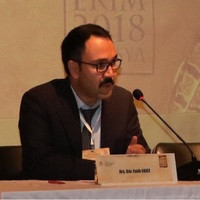Research Articles
Issue Editorial Board


 0000-0001-8910-7581
0000-0001-8910-7581




Aim & Scope
Journal of Literature and Humanities aims to contribute to the literature with original research articles and reviews that have high scientific quality in the field of language, literature and humanities.
The target audience of the journal consists of scientists, and professional workers and all people who are interested in language, literature and humanities.
Abstracting and Indexing
Journal of Literature and Humanities is covered in the following abstracting and indexing databases;
• DOAJ
• EBSCO
• TUBITAK ULAKBIM TR Index
• China National Knowledge Infrastructure (CNKI)
• ERIH Plus
• MLA International Bibliography
To guarantee that all papers published in the journal are maintained and permanently accessible, articles are stored in Dergipark which serves as a national archival web site and at the same time permits LOCKSS to collect, preserve, and serve the content.
Author Guidelines
You can access the Article Submission Guidelines here.
You can access the Article Submission Guidelines video here.
You can download the reference style for use in Vancouver and Zotero here.
Please download the article template here.
For comprehensive information regarding the journal's policies on submission, peer-review, publication, and ethical standards, kindly visit the Policies page. Similarly, for detailed information about the journal, please visit the Aims and Scope page.
Manuscripts submitted for evaluation should be original and not previously presented or published in any electronic or print medium. If a manuscript was previously presented at a conference or meeting, authors should provide detailed information about the event, including the name, date, and location of the organization.
Authors are required to prepare manuscripts in accordance with the relevant guideline listed below:
• Observational original research studies: STROBE guidelines
• Systematic reviews and meta-analysis: PRISMA guidelines (for protocols, please see the PRISMA-P guidelines)
• Nonrandomized evaluations of behavioral and public health interventions: TREND guidelines
• Qualitative research: SRQR guidelines
To find the right guideline for your research, please complete the questionnaire by Equator Network here.
Journal of Literature and Humanities encourages authors to follow the ‘Sex and Gender Equity in Research – SAGER – guidelines’ when preparing their manuscripts to promote the inclusion of sex and gender considerations in research. Before submission, authors can consult EASE Guidelines for Authors and Translators to produce clear, concise and accurate manuscripts that are easy to understand and free of common errors and pitfalls.
The style of manuscripts should follow the Publication Manual of the American Psychological Association (APA), Seventh Edition (2020).
Manuscripts can only be submitted through the journal’s online manuscript submission and evaluation system. Manuscripts submitted via any other medium and submissions by anyone other than one of the authors will not be evaluated.
The style of the manuscripts should be prepared according to the Publication Manual of the American Psychological Association (APA), Seventh Edition (journal revision).
Manuscripts submitted to the journal will first go through a technical evaluation process where the editorial office staff will ensure that the manuscript has been prepared and submitted in accordance with the journal’s guidelines. Submissions that do not conform to the journal’s guidelines will be returned to the submitting author with technical correction requests.
In addition to the manuscript files, authors are required to submit the following during the initial submission:
· Copyright Agreement and Acknowledgement of Authorship Form
Preparation of the Manuscript
Title page: A separate title page should be submitted with all submissions and this page should include:
· The full title of the manuscript as well as a short title (running head) of no more than 50 characters,
· Name(s), affiliations, highest academic degree(s), and ORCID IDs of the author(s),
· Grant information and detailed information on the other sources of support,
· Name, address, telephone (including the mobile phone number), and email address of the corresponding author,
· Acknowledgment of the individuals who contributed to the preparation of the manuscript but who do not fulfill the authorship criteria.
Abstract: A abstract must be submitted with all submissions. The abstract of Research Articles should be unstructured. The abstract should be no more than 250 words.
Keywords: All articles should be sent with at least 3 and maximum 6 keywords, and the keywords should be written just below the abstract. Abbreviations should not be used as keywords.
Manuscript Types
Research Articles: This is the most important type of article since it provides new information based on original research. Acceptance of original papers will be based upon the originality and importance of the investigation. The main text of original articles should be structured with Introduction, Discussion, and Conclusion and Recommendations subheadings. Please check Table 1 for the limitations for Original Articles.
Review Articles: Reviews prepared by authors who have extensive knowledge on a particular field and whose scientific background has been translated into a high volume of publications with a high citation potential are welcomed. These authors may even be invited by the journal. Reviews should describe, discuss, and evaluate the current level of knowledge of a topic in clinical practice and should guide future studies. The subheadings of the review articles should be planned by the authors. However, each review article should include an “Introduction” and a “Conclusion” section. Please check Table 1 for the limitations for Review Articles.
Table 1. Limitations for each manuscript type
| Type of manuscript | Word limit* | Abstract word limit | Reference limit | Table limit | Figure limit |
| Research Article | 10.000 | 250 | 50 | 6-10 | Max 15 images |
| Review Article | 8000 | 250 | 80 | 6-10 | Max 15 images |
*Word limit should not include the abstract, references, tables, and figure legends.
Tables
Tables should be included in the main document, and they should be numbered consecutively in the order they are referred to within the main text. A descriptive title must be placed above the tables in title case in italics. Abbreviations used in the tables should be defined below the tables by footnotes (even if they are defined within the main text). Tables should be created using the “insert table” command of the word processing software and they should be arranged clearly to provide easy reading. Data presented in the tables should not be a repetition of the data presented within the main text but should be supporting the main text.
Table Examples in APA Format
Source: Sample Tables, APA accessed https://apastyle.apa.org/style-grammar-guidelines/tables-figures/sample-tables
Figures and Figure Legends
Figures, graphics, and photographs should be submitted as separate files (in TIFF or JPEG format) through the submission system. The files should be included in the main text and should be uploaded as a word document or separately. When there are figure subunits, the subunits should not be merged to form a single image. Each subunit should be submitted separately through the submission system. Images should not be labeled (a, b, c, etc.) to indicate figure subunits. Thick and thin arrows, arrowheads, stars, asterisks, and similar marks can be used on the images to support figure legends. Like the rest of the submission, the figures too should be blind. Any information within the images that may indicate an individual or institution should be blinded. The minimum resolution of each submitted figure should be 300 DPI. To prevent delays in the evaluation process, all submitted figures should be clear in resolution and large in size (minimum dimensions: 100 × 100 mm).
All acronyms and abbreviations used in the manuscript should be defined at first use, both in the abstract and in the main text. The abbreviation should be provided in parentheses following the definition.
All references, tables, and figures should be referred to within the main text, and they should be numbered consecutively in the order they are referred to within the main text.
Limitations, drawbacks, and the shortcomings of original articles should be mentioned in the Discussion section before the conclusion paragraph.
Title Levels
First
Centered, bold, capital initial letters
The text starts with a new paragraph.
Second
Flush left, bold, initial letters uppercase
The text starts with a new paragraph.
Third
Flush left, bold, italic, initial letters uppercase
The text starts with a new paragraph.
Fourth
Indented, bold, capital initial letters, end with a point
The text begins on the same line with the title and continues as a standard paragraph.
Fifth
Indented, bold, capital initial letters, end with a point
The text begins on the same line with the title and continues as a standard paragraph.
References
Both in-text citations and the references must be prepared according to the APA Manual Seventh Edition.
While citing publications, preference should be given to the latest, most up-to-date publications. Authors are responsible for the accuracy of references. In the main text of the manuscript, references should be cited by author’s name and the publication year in parenthesis. In the case of direct citations in the main text, only publication year should be stated in parenthesis after the name of the author. Footnote style is also used in the Journal of Atatürk University Faculty of Letters, and the journal and book title should be written in italics. Please see below the examples.
Reference List
The reference styles for different types of publications are presented in the following examples.
Journal Article: Kahveci, K. (2021). The Return to Philosophy: The Views on The Discussion of Universals. Atatürk University Journal of Faculty of Letters, (67), 363-373.
Journal Article with more than one author: Kurnaz, C., & Tatçı, M. (1997). Ahmed Yesevî Hakkında Bir Bibliyografya Denemesi. Bilig, 4(1), 253-263.
Article in Turkish: Ünal, G. (2022). Çocuk Oyunlarının Bilişsel Gelişime Etkileri: “Eski Minder” ve “Deve-Cüce” Örnekleri [The Effects of Children’s Games on Cognitive Development: The Examples of “Eski Minder” & “Deve-Cüce”]. Atatürk University Journal of Faculty of Letters, (67), 332-344.
Books
By a Single Author: Caferoğlu, A. (1993). Eski Uygur Türkçesi Sözlüğü. Enderun Kitabevi Yayınları.
By Two or More Authors: İsen, M., Horata, O., Macit, M., Kılıç, F., & Aksoyak, İ. H. (2005). Eski Türk Edebiyatı El Kitabı. Grafiker Yayıncılık.
Edited Book: Gabain, A. V. (1988). Eski Anadolu Türkçesi Grameri. Mehmet Akalın (Çev.). Ankara: TDK Yayınları (Orijinali 1941’de yayımlanmıştır).
Dissertation or Thesis: Valentin, E. R. (2019, Summer). Narcissism predicted by Snapchat selfie sharing, filter usage, and editing [Master's thesis, California State University Dominguez Hills]. CSU ScholarWorks. https://scholarworks.calstate.edu/concern/theses/3197xm925?locale=en
No Author: Kütüphaneciliğimiz Üzerine Görüşler. (1987). Kültür ve Turizm Bakanlığı.
Web sites: Sparks, Dana. (2018, September 12). Mayo mindfulness: Practicing mindfulness exercises. Mayo Clinic.
In the seventh edition, up to 20 authors should now be included in a reference list entry. For sources with more than 20 authors, after the 19th listed author, any additional authors' names are replaced with an ellipsis (…) followed by the final listed author's name:
Author, A. A., Author, B. B., Author, C. C., Author, D. D., Author, E. E., Author, F. F., Author, G. G., Author, H. H., Author, I. I., Author, J. J., Author, K. K., Author, L. L., Author, M. M., Author, N. N., Author, O. O., Author, P. P., Author, Q. Q., Author, R. R., Author, S. S., . . . Author, Z. Z.
REVISIONS
When submitting a revised version of a paper, the author must submit a detailed “Response to the reviewers” that states point by point how each issue raised by the reviewers has been covered and where it can be found (each reviewer’s comment, followed by the author’s reply and line numbers where the changes have been made) as well as an annotated copy of the main document. Revised manuscripts must be submitted within 30 days from the date of the decision letter. If the revised version of the manuscript is not submitted within the allocated time, the revision option may be canceled. If the submitting author(s) believe that additional time is required, they should request this extension before the initial 30-day period is over.
Accepted manuscripts are copy-edited for grammar, punctuation, and format by professional language editors. Once the publication process of a manuscript is completed, it is published online on the journal’s webpage as an ahead-of-print publication before it is included in its scheduled issue. A PDF proof of the accepted manuscript is sent to the corresponding author and their publication approval is requested within 2 days of their receipt of the proof.
Ethical Principles and Publication Policy
Journal of Literature and Humanities is an open access publication.
Starting on January 2022, all content published in the journal is licensed under the Creative Commons Attribution-NonCommercial (CC BY-NC) 4.0 International License which allows third parties to use the content for non-commercial purposes as long as they give credit to the original work. This license allows for the content to be shared and adapted for non-commercial purposes, promoting the dissemination and use of the research published in the journal.
The content published before January 2022 was licensed under a traditional copyright, but the archive is still available for free access.
All published content is available online, free of charge at https://dergipark.org.tr/en/pub/literatureandhumanities
When using previously published content, including figures, tables, or any other material in both print and electronic formats, authors must obtain permission from the copyright holder. Legal, financial and criminal liabilities in this regard belong to the author(s).
Copyright Policy
Journal of Literature and Humanities requires each submission to be accompanied by a Copyright Agreement and Acknowledgement of Authorship form (available for https://dergipark.org.tr/en/pub/literatureandhumanities). By signing this form, authors retain the copyright of their work and agree that the article, if accepted for publication by the Journal of Literature and Humanities will be licensed under a Creative Commons Attribution-NonCommercial (CC BY-NC) 4.0 International License which permits third parties to share and adapt the content for non-commercial purposes by giving the appropriate credit to the original work.
Authors retain the copyright of their published work in the Journal of Literature and Humanities.
Self-Archiving Policy
Authors retain the right to self-archive their work on their institutional or personal websites, as well as in open access repositories, after publication. It is expected that authors appropriately acknowledge the original publication and include the DOI number when sharing their articles. Additionally, authors are requested to provide a link from the deposited version to the URL of the publisher's website. This requirement is intended to safeguard the integrity and authenticity of the scientific record, with the online published version on the publisher's website clearly identified as the definitive version of record.
Publication Fee Policy
Journal of Literature and Humanities is funded by the Atatürk University.
Authors are not required to pay any fees during the evaluation and publication process.
Advertising Policy
Journal of Literature and Humanities accepts digital advertisements on its website. These ads must be approved by the journal's Editorial Board and management, and must be clearly labeled as advertisements. Advertisers have no influence on editorial decisions or advertising policies.
Those interested in advertising in the journal should contact the Editorial Office.
Peer Review Process
Manuscripts submitted to Journal of Literature and Humanities will go through a double anonymized peer-review process where both authors and reviewers are anonymous to each other. Each submission will be reviewed by at least two external, independent peer reviewers who are experts in their fields in order to ensure an unbiased evaluation process.
Submissions will first go through a technical evaluation process during which the editorial office staff will ensure that the manuscript was prepared and submitted in accordance with the journal’s guidelines. Submissions that do not conform to the journal’s guidelines will be returned to the submitting authors with technical correction requests.
Submissions that conform to the journal’s guidelines will be assigned to the Editor in Chief who will assess each submission’s suitability to the journal in terms of scope and quality. Submissions that are not suitable for the journal can be rejected at this stage.
For papers that are suitable for the journal, the Editor in Chief will work with Associate Editors who will recruit reviewers for the manuscript. Once assigned, Associate Editors can decide to reject a manuscript, continue with the peer review process, or request revisions before further peer-review.
Associate editors will submit their recommendations that are based on reports submitted by the reviewers to the Editor in Chief. Revised manuscripts will be reassessed by the Associate Editors who will aim to work with the original reviewers to make a new recommendation.
The Editor in Chief is the final authority in the decision-making process for all submissions.
In the event of delays, authors will be informed of the reason for the delay and given the opportunity to withdraw their manuscript.
Once the peer-review process is completed, the authors will receive anonymous peer-review reports along with the editorial decision on their manuscript. Peer-review reports will not be posted publicly in any medium. The submitted material is considered confidential and must not be used in any way until after its publication. If it is suspected that a reviewer has appropriated an author’s ideas or data, the Editorial Board will handle the matter in accordance with the relevant COPE’s guideline.
Authors can recommend peer-reviewers during submission. The handling editor is the sole authority to decide whether or not recommended peer-reviewers will be invited to evaluate the manuscript.
Peer reviewers are required to adhere to the principles of COPE's Ethical Guidelines for Peer-reviewers and these guidelines provide a framework for reviewers to follow in order to ensure the integrity and fairness of the peer review process. The Editorial Board follows COPE’s relevant flowchart to minimize peer review manipulation. If there is suspicion of peer review manipulation after publication, the Editorial Board will follow the appropriate flowchart of COPE.
Potential peer reviewers should inform the Editor of any possible conflicts of interest before accepting an invitation to review a manuscript. Informing the editor of any potential conflicts of interest allows them to make an informed decision about whether or not to invite the potential reviewer to participate in the review process. It also helps to ensure the integrity and transparency of the review process.
Communications between Editors and peer reviewers contain confidential information that should not be shared with third parties.
Journal of Literature and Humanities will recruit external editors to handle peer review processes of manuscripts submitted by members of the editorial board. If one of the editorial board sends an article; Atatürk University Coordinatorship of Scientific Journals searches for an expert in the field, outside Atatürk University and independent of the author's institution, and sends an editorial invitation for the article. The invited editor is asked to proceed with the double-blind reviewer evaluation process by creating a record in the system and to follow up. The invited editor is independent in his decision.
If an article's peer review is an exception to the journal’s usual policy, the type of the review it received will be displayed on the article to ensure the transparency and accountability of the review process.
Revisions
Submitting authors of manuscripts that require a “minor revision” or a “major revision” will receive the decision letter from the Editor in Chief. The decision letter will include the suggestions of the reviewers and editors along with a deadline to submit the revised and updated version of the manuscript.
When submitting a revised version of a paper, authors must submit a detailed “Response to the reviewers” that states point by point how each issue raised by the reviewers has been covered and where it can be found (each reviewer’s comment, followed by the author’s reply and line numbers where the changes have been made) as well as an annotated copy of the main document.
Revised manuscripts must be submitted within the time frame specified in the decision letter. If the revised version of the manuscript is not submitted within the allocated time, the revision option may be canceled. If the submitting author(s) believe that additional time is required, they should request an extension before the initial period is over.
Publication Ethics
Journal of Literature and Humanities aims to adhere to the guidelines and core practices set forth by several organizations, including the Committee on Publication Ethics (COPE) guidelines and the Principles of Transparency and Best Practice in Scholarly Publishing (joint statement by COPE, DOAJ, OASPA, WAME). These guidelines and recommendations are designed to promote transparency, integrity, and best practices in scholarly publishing. By adhering to these standards, the journal aims to ensure that the research it publishes is of high quality and meets the ethical standards of the scientific community.
Authors are advised to use EASE Ethics Checklist for Authors to ensure that their manuscripts comply with ethical standards and practices.
All research involving human subjects, medical records, or human tissues must be reviewed and approved by a reviewer board, such as an institutional review board (IRB) or ethics committee, before it is conducted. The name of the ethics committee that reviewed and approved the research, as well as the ethics committee approval number and date, should be included in the Methods section of the manuscript when it is submitted for publication. Additionally, the journal may require authors to provide a copy of the ethics committee approval as part of the manuscript submission process. This is to ensure that the research has been properly reviewed and approved, and to allow the journal to verify that the research meets the ethical standards required for publication.
If a study is exempted from the ethics committee approval, the authors must present a statement from the ethics committee explaining the reason for the exemption. This is to ensure that the research was reviewed by an ethics committee and that the decision to exempt the study was made in accordance with the relevant guidelines and regulations.
If a manuscript is submitted to Journal of Literature and Humanities without ethics committee approval, the journal will review the manuscript according to the COPE’s Research, Audit and Service Evaluations guideline. This guideline provides guidance on how to handle manuscripts that do not have ethics committee approval, and allows the journal to assess the risks and potential ethical concerns associated with publishing the research.
In the case of research involving children under the age of 18, the parent or guardian of the child must provide informed consent on behalf of the child. This is because children are considered to be a vulnerable population and may not have the capacity to fully understand the risks and benefits of participating in research.
If the manuscript reports the findings of a survey or interviews, the author must confirm that the participants gave their informed consent to participate in the study and for their personal details to be recorded if that is the case. If quotations or other attributable statements are included, these must be deidentified, or the manuscript must state that the person agreed to be named in the manuscript.
It is the responsibility of the authors to protect the anonymity of study participants, and to ensure that the research is conducted in a way that respects their privacy and confidentiality. This is especially important for photographs that may reveal the identity of patients, as the publication of such photographs without proper consent could potentially violate the rights of the individuals depicted.
To protect the anonymity of participants in photographs, the authors should obtain signed releases from the participants or their legal representatives. These releases should indicate that the participants have given their consent for the publication of the photographs, and should specify any restrictions or conditions on the use of the photographs. Information on the publication approval for photographs should be provided in the manuscript.
Plagiarism and Ethical Misconduct
All submissions are screened by a similarity detection software (Crossref Similarity Check Powered by iThenticate) multiple times during the peer-review and/or production processes.
When you are discussing others' (or your own) previous work, make sure that you cite the material correctly in every instance.
Authors are strongly recommended to avoid any form of plagiarism and ethical misconduct that are exemplified below.
• Citation manipulation: The practice of manipulating the number of citations received by an author, journal, or other publication through various means, such as self-citation, excessive citation of articles from the same journal, or the inclusion of honorary citations or citation stacking.
• Self- plagiarism (text-recycling): The practice of using overlapping sections or sentences from the author's previous publications without properly citing them. This is considered to be a form of plagiarism, as it involves using someone else's work (in this case, the author's own work) without proper attribution.
• Salami slicing: The practice of using the same data from a research study in several different articles. This is considered to be unethical, as it involves reporting the same hypotheses, population, and methods of a study in multiple papers.
• Data Fabrication: The addition of data that never occurred during the gathering of data or experiments. This is considered to be a form of research misconduct, as it involves presenting false or misleading information as if it were real data.
• Data Manipulation/Falsification: The practice of manipulating research data with the intention of giving a false impression. This can include manipulating images, removing outliers or "inconvenient" results, changing data points, and other forms of manipulation. This is also considered to be a form of research misconduct, as it involves presenting false or misleading information as if it were real data.
In the event of alleged or suspected research misconduct such as plagiarism, citation manipulation, or data falsification/fabrication, the Editorial Board will follow the appropriate COPE flowcharts to ensure that the allegations or suspicions are handled in a fair, transparent, and consistent manner.
AUTHORSHIP
All individuals listed as an author should meet the authorship criteria recommended by the International Committee of Medical Journal Editors (ICME). The ICMJE recommends that authorship is based on the following four criteria:
1. Substantial contributions to the conception or design of the work; or the acquisition, analysis, or interpretation of data for the work.
2. Drafting the work or revising it critically for important intellectual content.
3. Final approval of the version to be published.
4. Agreement to be accountable for all aspects of the work in ensuring that questions related to the accuracy or integrity of any part of the work are appropriately investigated and resolved.
In addition to being accountable for the parts of the work they have done, authors should also be able to identify which co-authors are responsible for specific other parts of the work to ensure that the contributions of all authors are accurately and appropriately acknowledged. Authors may use CRediT (Contributor Roles Taxonomy) to provide information about individual contributions at the time of submission. It is expected that all authors agreed upon their individual contributions as shared by the corresponding author. The authors’ contribution statement will be published with the final article and should accurately reflect contributions to the work.
Furthermore, authors should have confidence in the integrity of the contributions of their co-authors. This means that they should trust that their co-authors have conducted the research in an ethical and responsible manner, and that the data and results presented in the manuscript are accurate and reliable.
Individuals who do not meet all four of the authorship criteria should not be included as authors on the manuscript. However, they can still be acknowledged on the title page of the manuscript for their contributions to the research in order to recognize the contributions of these individuals and to provide transparency about who was involved in the research.
If the editorial board suspects a case of ghost, honorary or gift authorship, the submission will be suspended and the relevant COPE flowchart and COPE Policy on authorship and contributorship will be followed.
Change of Authorship
Any requests for changes to authorship, such as the removal or addition of authors, or changes in the order of authors, should be submitted to the editorial office with a letter stating the reasons for the change. The letter must be signed by all authors, including any who have been removed.
The journal’s Editorial Board will handle all requests for changes to authorship in a consistent and transparent manner, following the relevant COPE flowchart guidelines. These procedures are in place to protect the integrity of the research and the reputation of all involved authors.
Declaration of Interests
Authors must reveal any relationships or interests that may lead to an inappropriate influence or bias in their work. This should be done by disclosing any possible conflicts of interest through the online submission system while submitting their manuscript.
Journal of Literature and Humanities also requires and encourages individuals involved in the peer review process of submitted manuscripts to disclose any existing or potential competing interests that might lead to potential bias.
The Editorial Board will handle cases of potential competing interests of editors, authors, or reviewers within the scope of relevant COPE flowcharts.
The Role of Artificial Intelligence (AI) in Manuscript Preparation
Journal of Literature and Humanities follows the guidelines outlined by the Committee on Publication Ethics (COPE) with regards to the utilization of AI and AI-assisted technology in manuscript preparation. Authorship encompasses a range of tasks that can only be performed by humans, and authors are accountable for ensuring the article's originality and possessing the requisite qualifications for authorship. While AI can be employed for language corrections during the article writing process (and this should be explicitly stated in the article), it cannot be included as an author, as it is essential to maintain the originality and quality of the article.
Financial Disclosure
Journal of Literature and Humanities requires authors to disclose any financial support they received to conduct their research. This information should be included in the funding statement, which should be provided when the manuscript is submitted to the journal.
The funding statement should include the name of any granting agencies, the grant numbers, and a description of each funder's role in the research. If the funder had no role in the research, this should be stated in the funding statement as well. This information is important for readers to understand the potential biases and conflicts of interest that may exist in the research.
Post-Publication Correction Requests and Retractions
All post-publication correction requests are subject to editorial review. The editorial board will review the request and determine whether the correction is necessary and appropriate. The decision to publish a correction will be based on the nature of the error, its potential impact on the article, and the availability of supporting evidence. The editorial board may also consult with the authors, reviewers, and other experts as needed to make its decision. If the correction request is approved, the article will be corrected in the journal's archive.
The Editorial Board reviews cases following journal policies and COPE guidelines.
If misconduct allegations are made by whistleblowers directly, the Editorial Board will follow the relevant COPE’s flowchart. The journal will act in accordance with the COPE's flowchart on how to respond to whistleblowers when concerns are raised about a published article on a social media site.
In some cases, an ombudsperson may be assigned to resolve claims that cannot be resolved internally.
To investigate potential ethical misconduct, the editorial board may share information with other editors-in-chief to conduct investigations more efficiently and effectively. If communication with the editor-in-chief is necessary, the editorial board will follow the relevant COPE's recommendations.
If necessary, the journal may also contact institutions to inform them of suspected misconduct by researchers and provide evidence to support these concerns, following COPE guidelines in the process.
In the event of ethical misconduct concerns, the editors will investigate the case according to COPE guidelines. If the investigation verifies the concern, the editors may issue a retraction notice. The retraction notice will be published in the journal and the article's record will be updated to reflect the retraction. The article will remain in the archives of the journal, but it will be clearly marked as retracted. The article's record will also be updated in the relevant indexes to reflect the retraction.
Withdrawal Requests
Withdrawal requests for an article are reviewed by the editorial board of the journal. To request the withdrawal of an article, the authors must send a letter signed by all authors stating their request and the reasons for withdrawal to the journal editor. The editorial board will then review the request and make a decision based on the reasons provided by the authors. If the request is approved, the article will be withdrawn from the journal and the authors will be notified of the decision. It is important to note that authors should not submit their work to another journal for evaluation until the withdrawal request has been approved. This is to avoid any potential conflicts of interest or duplication of publication.
Appeals and Complaint
The editorial board of the journal is responsible for addressing appeals and complaints in accordance with the guidelines and recommendations of the COPE. If an author has an appeal or complaint, they should contact the editorial office directly to discuss their concerns. The editorial board will review the case and make a decision based on COPE guidelines.
The editor-in-chief has the final authority in the decision-making process for all appeals and complaints. In some cases, an ombudsperson may be assigned to resolve claims that cannot be resolved internally. It is important to note that the journal follows a fair and transparent process for handling appeals and complaints, with the goal of preserving the integrity of the scientific record.
Preprint Policy
Journal of Literature and Humanities does not consider preprints as prior publication, which means that authors are allowed to present and discuss their findings on a non-commercial preprint server before submitting their work to the journal.
However, authors must provide the journal with the preprint server deposition of their article, along with its DOI, during the initial submission process.
If the article is accepted and published in the journal, it is the responsibility of the authors to update the archived preprint and link it to the published version of the article. This helps to ensure that readers can easily access the most up-to-date and accurate information.
Permission Policy
As of the January 2022 issue, the journal's content is licensed under a Creative Commons Attribution-NonCommercial 4.0 International License (CC BY-NC 4.0).
Under this license, users are allowed to share, adapt, reproduce and distribute the journal's content for non-commercial purposes, provided that they give appropriate credit to the original author and the journal.
Atatürk University is the copyright holder of content published before January 2022.
DISCLAIMER
The statements or opinions expressed in the manuscripts published in the journal reflect the views of the author(s) and not the views of the editors, editorial board, and/or publisher. The editors, editorial board, and publisher are not responsible for the content of the manuscripts and do not necessarily endorse the views expressed in them. It is the responsibility of the authors to ensure that their work is accurate and well-researched, and the views expressed in their manuscripts are their own. The editors, editorial board, and publisher simply provide a platform for the authors to share their work with the scientific community.
Price Policy
Journal of Literature and Humanities is funded by the Atatürk University. Authors are not required to pay any fees during the evaluation and publication process.
Content of this journal is licensed under a Creative Commons Attribution NonCommercial 4.0 International License

